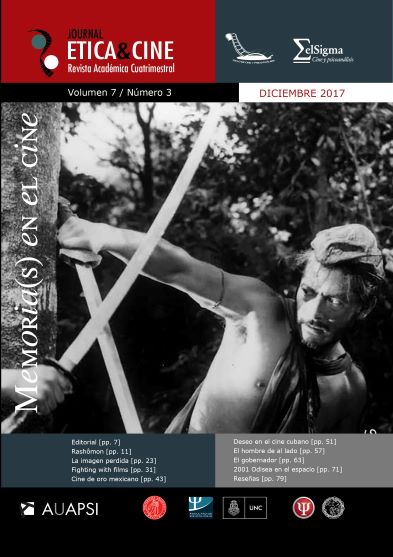Fighting with films
DOI:
https://doi.org/10.31056/2250.5415.v7.n3.19622Keywords:
Political Communication, Propaganda, Publicity Advertising, Film Discourse, Discourse analysisAbstract
The article analyzes film discourse, both informative and fiction, in the United States during the First World War. The article places “the division of films” in the framework of the complex campaign of institutional communication started by W. Wilson’s government after the war declaration by analyzing “publicity” and “propaganda” strategies deployed by the Committee on Public Information, which was created ad hoc for the military campaign. On the one hand, the paper explores the film stories, both documentary and fiction, distribution apparatus in both the United States and the international markets, the administration policies and the involved agencies, especially in the international distribution. On the other hand, it examines the model of production concerning the contracts signing with film companies and the organization adopted by the Committee on Public Information to create its own productions and participate in joint projects with film companies. The paper places emphasis on the “theory” developed by the Committee on Public Information about script-writing and film staging, particulary on the case of documentary stories, which were based in a model, hybridized with fiction stories, in order to stimulate demand for “educational”, “propaganda” film-making, to which the exhibitors initially showed signs of resistence. The paper also highlights, in overall terms, how iconical representation was categorized and, in particular, the assessment on the role silent cinema can play in the Committee’s development of communicative strategies. In spite of the Comittee’s avoidance of the “propaganda” category, as its own name shows, iconical representation was given “highest propaganda value” and was granted a place of privilege, particularly, in the international campaign’s call to spread “the gospel of americanism” around the globeDownloads
References
Bazin, A. (1975). “Ontologie et langage” en Qu’est-ce que le cinéma, 1. Paris: Editions du Cerf.
Bernays, E. (1928). Propaganda Retrieved from http://www.historyisaweapon.com/def. [Consultado el 15 de noviembre de 2015]
The Engineering of Consent. Retrieved from http://gromitinc.com/lego/Library/E. [Consultado el 15 de noviembre de 2015]
Creel, G. (1918). “Public Opinion in War Time”, en Annals of the American Academy or Political and Social Science, 78, pp. 185-194.
D’Aymery, G. (2001). «Propaganda: Then and Now». Retrieved from http://whatreallyhappened.com/WRHAR.> [Consultado el 15 de noviembre de 2015].
Eco, U. (2000). Tratado de semiótica general. Barcelona: Lumen.
Gavaldà, J. (2013). “Hibridación discursiva y programación televisiva: infoshow y docufiction”, en AA. VV. El documental en el entorno digital. Barcelona: UOC.
Habermas, J. (1994). Historia y crítica de la opinión pública. La transformación estructural de la vida pública. Barcelona: G. Gili.
Lasswell, H. (1927). Propaganda Technique in the World War. New York: P. Smith.
Lippmann, W. (1961). Public Opinion. New York: Macmillan.
Mattelart, A. (1993). La comunicación-mundo. Historia de las ideas y de las estrategias. Madrid: Fundesco.
Ricoeur, P. (1987). Tiempo y narración I, II, III. Barcelona: Cristiandad.
Ricoeur, R. (1999). Historia y narratividad. Barcelona: Paidós.
Ricoeur, R. (2000)."Narratividad, fenomenología y hermeneútica", Anàlisis, 25.
Rorty, R. (1996). Consecuencias del pragmatismo, Madrid: Tecnos.
Sloterdijk, P. (2003). Temblores del aire. Valencia: Pre-Textos.
Vaughn, S (1980). Holding Fast the Inner Lines: Democracy, Nationalism, and the Committee on Public Information. Chapel Hill: University of North Carolina Press.
Vidal, G. (1990). Hollywood. Barcelona: Edhasa.
Vidal, G. (2001). El último imperio. Madrid: Síntesis.
Wittgenstein, L. (1983). Investigacions filosòfiques. Barcelona: Laia.
Downloads
Published
How to Cite
Issue
Section
License
Los autores que publiquen en Ética y Cine Journal aceptan las siguientes condiciones:
Los autores/as conservan los derechos de autor © y permiten la publicación a Ética y Cine Journal, bajo licencia CC BY-SA / Reconocimiento - Reconocimiento-CompartirIgual 4.0 Internacional. La adopción de esta licencia permite copiar, redistribuir, comunicar públicamente la obra, reconociendo los créditos de la misma, y construir sobre el material publicado, debiendo otorgar el crédito apropiado a través de un enlace a la licencia e indicando si se realizaron cambios.

Este obra está bajo una licencia de Creative Commons Reconocimiento-CompartirIgual 4.0 Internacional.




